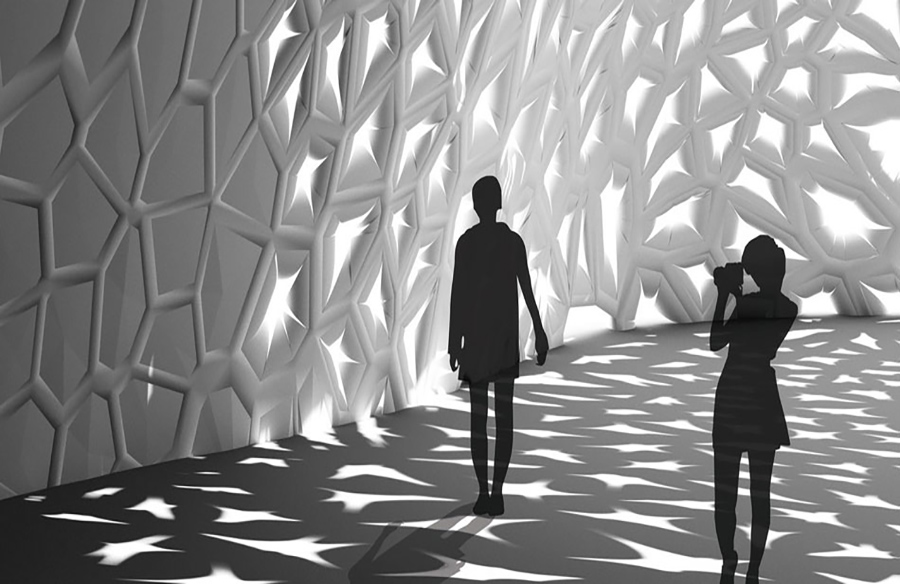This project is about a supplemental skin that respires. It is a garment for the modern human, who wanders during the day in the city, a “microenvironment” around the wearer that interacts with the broader changing environment and helps to maintain the condition of thermal comfort.
First Award | RTFA 2017 Awards
Category: Product Design (Concept)

| Project Details | |
| Participant Name: | Efthymia Douroudi & Lantavou Maria Lantavou |
| Country: | Greece |
![Re[in]Spired Architecture | Efthymia Douroudi & Lantavou Maria Lantavou - Sheet2](https://indiaarchitectureawards.com/wp-content/uploads/2023/09/ReinSpired-Architecture-by-Efthymia-Douroudi-amp-Lantavou-Maria-Lantavou-2.jpg)
©Efthymia Douroudi & Lantavou Maria Lantavou
The design intends to answer multiple questions. The main design axes are related to curvature, adaptivity and thermal comfort. The size and shape of components that makes up the surface is the first design parameter, affected by the curvature of the body and acts globally like scales. The second design parameter acts locally, so each component has the ability to open and close, influenced by environmental conditions (humidity and temperature). The place of the opening and closing components depends on the sweating body parts and the rhythm that the sweat is producing in each part. In this way we define areas where the garment needs more punching to achieve natural ventilation that leads to cooling and thus to thermal comfort. Three-dimensional illustrations of the garment are represented with closed and opened components, so you can see how it is shifting to different temperatures.
![Re[in]Spired Architecture | Efthymia Douroudi & Lantavou Maria Lantavou - Sheet3](https://indiaarchitectureawards.com/wp-content/uploads/2023/09/ReinSpired-Architecture-by-Efthymia-Douroudi-amp-Lantavou-Maria-Lantavou-3.jpg)
©Efthymia Douroudi & Lantavou Maria Lantavou
This garment is to be printed in multi material 3D printer. The entire surface will be composed of flexible material, for example filaflex which is a thermoplastic elastomer based polyurethane filament. This is a 700% flexible, soft material. The same printer, with different material deposition head, will incorporate at the same time smart material in components, giving them the ability to move triggered by the environment temperature. It could be self-transforming carbon fibber programmed to transform autonomously by heat as an activator (Self-Assembly Lab, Autodesk Inc, International Design Center, MIT). As a result components open and close contributing to the cooling of the body.
There are models that simulate a dress, based on the discussed parameters: a model of elastic fabric, where panelisation can be observed, a 3d printed mesh for further experimentation and a model with components of carbon.
![Re[in]Spired Architecture | Efthymia Douroudi & Lantavou Maria Lantavou - Sheet4](https://indiaarchitectureawards.com/wp-content/uploads/2023/09/ReinSpired-Architecture-by-Efthymia-Douroudi-amp-Lantavou-Maria-Lantavou-4.jpg)
©Efthymia Douroudi & Lantavou Maria Lantavou
- ©Efthymia Douroudi & Lantavou Maria Lantavou
- ©Efthymia Douroudi & Lantavou Maria Lantavou
- ©Efthymia Douroudi & Lantavou Maria Lantavou
![Re[in]Spired Architecture | Efthymia Douroudi & Lantavou Maria Lantavou - Sheet1](https://indiaarchitectureawards.com/wp-content/uploads/2023/09/ReinSpired-Architecture-by-Efthymia-Douroudi-amp-Lantavou-Maria-Lantavou-1-150x150.jpg)
![Re[in]Spired Architecture | Efthymia Douroudi & Lantavou Maria Lantavou - Sheet2](https://indiaarchitectureawards.com/wp-content/uploads/2023/09/ReinSpired-Architecture-by-Efthymia-Douroudi-amp-Lantavou-Maria-Lantavou-2-150x150.jpg)
![Re[in]Spired Architecture | Efthymia Douroudi & Lantavou Maria Lantavou - Sheet3](https://indiaarchitectureawards.com/wp-content/uploads/2023/09/ReinSpired-Architecture-by-Efthymia-Douroudi-amp-Lantavou-Maria-Lantavou-3-150x150.jpg)
![Re[in]Spired Architecture | Efthymia Douroudi & Lantavou Maria Lantavou - Sheet4](https://indiaarchitectureawards.com/wp-content/uploads/2023/09/ReinSpired-Architecture-by-Efthymia-Douroudi-amp-Lantavou-Maria-Lantavou-4-150x150.jpg)
![Re[in]Spired Architecture | Efthymia Douroudi & Lantavou Maria Lantavou - Sheet5](https://indiaarchitectureawards.com/wp-content/uploads/2023/09/ReinSpired-Architecture-by-Efthymia-Douroudi-amp-Lantavou-Maria-Lantavou-5-150x150.jpg)


